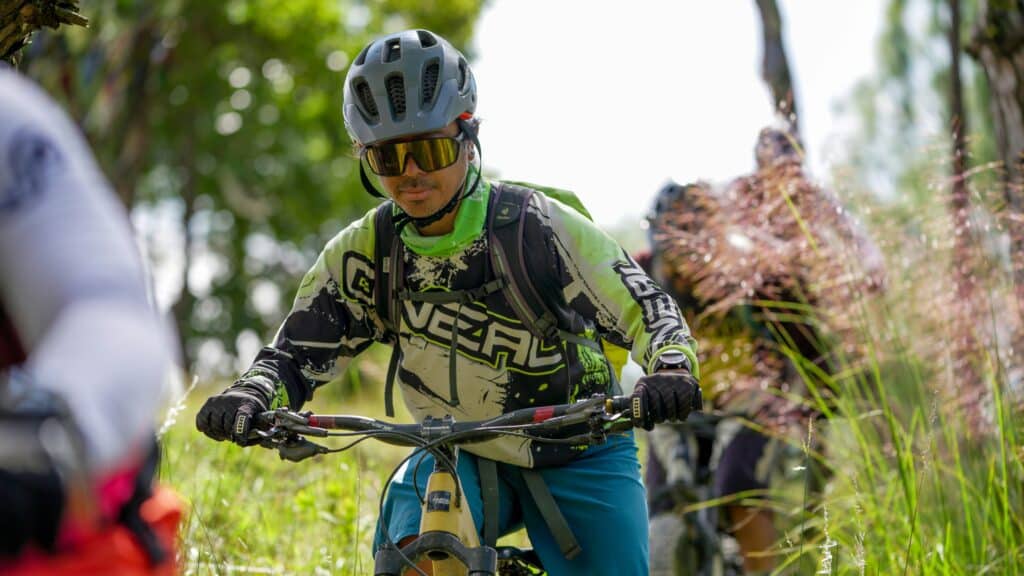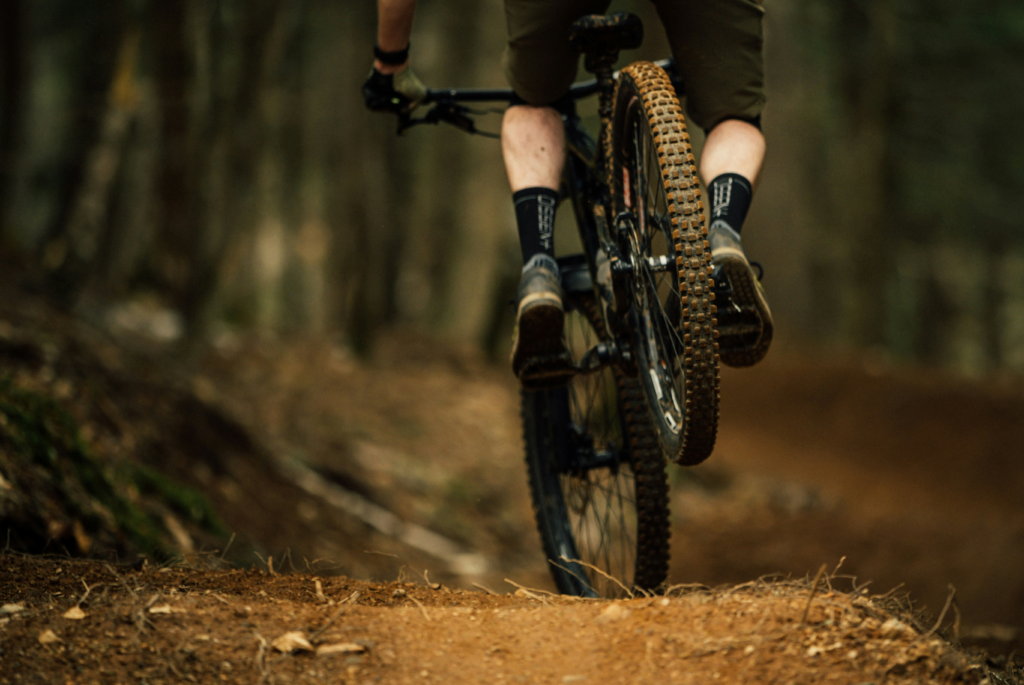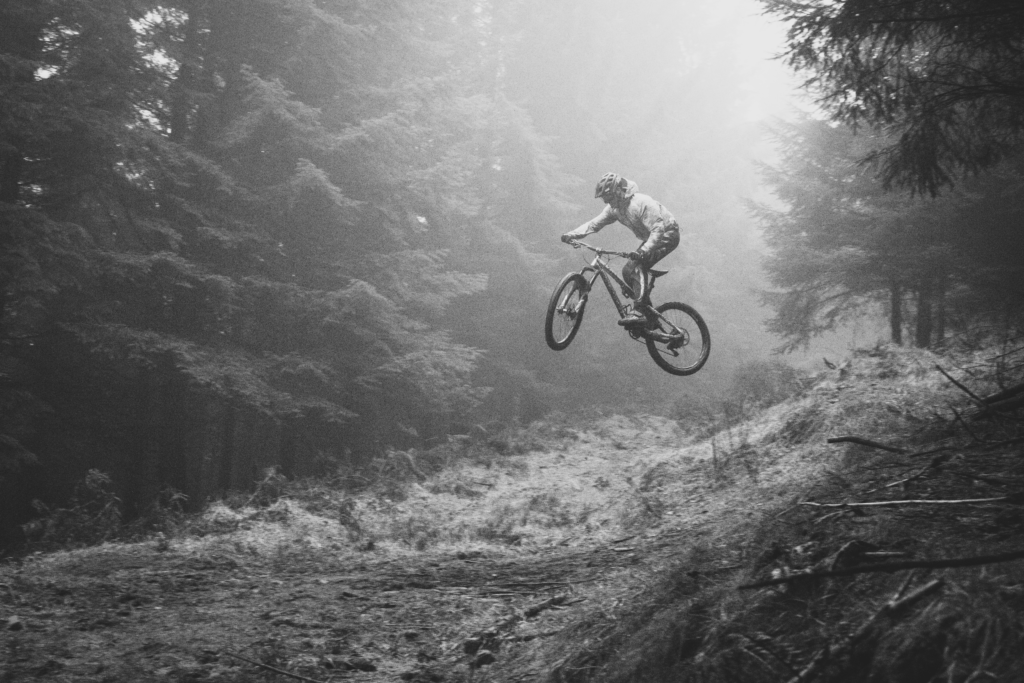What’s the difference?
Mountain biking isn’t one-size-fits-all. From pedaling uphill marathons to launching off drops, different types of mountain bike exist for different riding styles. The variety can seem overwhelming at first—cross country, trail, enduro, downhill, and even subcategories within those. But understanding the different types of mountain bike will help you find the perfect ride for how you actually want to ride.
Let’s break down the major types of mountain bike, what makes each one unique, and who they’re really designed for.

Cross Country (XC)
The Marathon Runner
Cross country bikes are built for one thing: covering ground quickly. These bikes are the lightest and most efficient types of mountain bike. They have 100-120mm of suspension travel. That’s the amount the suspension can compress to absorb bumps. Some XC bikes are hardtails, which means they only have front suspension.
The geometry puts you in a forward position. This helps you pedal harder and climb faster. The front wheel sits close to your body. This makes the bike feel quick and responsive. Everything about an XC bike says “go faster.” Carbon frames keep weight down. Narrow handlebars improve aerodynamics. Firm suspension reduces energy loss. Many have a lockout feature that stops the suspension from moving on smooth climbs.
Modern XC bikes have changed a lot. Today’s “downcountry” bikes blur the line between XC and trail bikes. They handle descents better without losing too much climbing speed. But traditional XC bikes remain focused on one goal: efficiency.
Best for: Competitive racers. Fitness-focused riders who love logging miles. Anyone who loves efficient climbing. If you see technical descents as obstacles rather than the main event, XC is for you.

Trail
The All-Rounder
Trail bikes are the most popular types of mountain bike. It’s easy to see why. With 120-150mm of suspension travel, these bikes balance climbing and descending. They’re good at everything without major compromises.
The geometry sits in the middle. It’s slack enough to feel stable at speed. It’s steep enough to climb without fighting the bike. You can pedal uphill for hours. Then you can descend technical terrain with confidence.
What makes trail bikes special is their versatility. They’re light enough for cross-country loops. They’re capable enough for bike park features. You can manual over obstacles pump through berms. You can have fun without the bike feeling too heavy or sluggish. The suspension balances support for pedaling with smoothness over rough terrain.
Trail bikes have the widest appeal. They match how most people actually ride. You climb, you descend, you play around on varied terrain. They’re not the fastest climbers. They’re not the most confidence-inspiring descenders. But they’re good enough at both that you’ll rarely feel limited.
Best for: Weekend warriors. Riders exploring local trails. Anyone who wants one bike that handles everything well. If you’re not sure what kind of rider you are yet, start here.
All-Mountain
The Crossover
All-mountain bikes sit between trail and enduro bikes. They typically have 140-160mm of travel. The term is less common now. “Trail” has expanded to include lighter all-mountain bikes. “Enduro” has claimed the more aggressive ones. But the concept remains useful.
These bikes handle steep, sustained climbs better than enduro bikes. They offer more confidence on rowdy descents than trail bikes. They’re ideal for big mountain adventures. Both the ups and downs matter equally.
Best for: Backcountry explorers. Riders tackling serious elevation in remote areas. Anyone doing multi-hour rides with significant technical descending.

Enduro
The Descending Specialist
Enduro bikes are where things get serious about going downhill. With 150-180mm of suspension travel, these bikes are built for aggressive, high-speed descending. They’re named after the racing discipline. Riders pedal between timed downhill stages. Only the descents count. But you still need to pedal yourself to each stage start.
The geometry is designed for stability at speed. The front wheel sits farther from your body. This improves weight distribution on steep descents. The increased suspension absorbs bigger impacts. The overall build is tougher. Stronger wheels. More robust frames. Beefier components.
But enduro bikes aren’t downhill bikes. They still climb. Many have adjustable geometry. Flip chips can steepen angles for climbing. Suspension platforms firm up the shock for better pedaling. Yes, they’re heavier and slower uphill than trail bikes. But they’re designed for riders who view climbing as the price of admission for great descents.
Modern enduro bikes often feature adjustable settings. Many use “climb switches” that firm up the rear shock. This reduces bobbing and improves efficiency on fire roads. The best enduro bikes disappear beneath you on descents. They give you confidence to push harder. You can ride faster on terrain that would feel sketchy on a trail bike.
Best for: Advanced riders who prioritize technical descending. Those regularly tackling steep and challenging terrain. Enduro racers. Riders who shuttle or use lifts for some laps but still pedal for others. If you think “I wish my bike felt more stable on this descent,” enduro might be your answer.

Downhill (DH)
The Gravity Missile
Downhill bikes have one purpose: getting down the mountain as fast as possible. With 180-220mm of suspension travel, these are the most extreme types of mountain bike. They have dual-crown forks. These clamp the fork legs above and below the head tube for extra stiffness. The geometry is so slack you’d never pedal uphill. These bikes are built exclusively for lift-accessed or shuttle-accessed descending.
Everything prioritizes stability, traction, and control at high speeds. The long wheelbase and slack angles make the bike stable at speed. But they make it nearly impossible to maneuver slowly or uphill. They’re heavy—35-40+ pounds. Weight doesn’t matter when you’re not pedaling up. The extra bulk comes from stronger, more durable parts. These are designed to withstand repeated big hits.
DH bikes often use coil shocks instead of air shocks. Coil shocks are more consistent and plush through repeated hits. The suspension is tuned for maximum traction and impact absorption. Not pedaling efficiency. Even the gearing reflects the mission. You might have seven speeds total. Just enough to adjust for changing gradient on the way down.
Best for: Bike park enthusiasts. Gravity-focused riders with consistent access to lifts or shuttles. Downhill racers. If you’ve separated climbing and descending entirely, this is your bike. You need access to the top of the mountain without pedaling.
So Which One Should You Choose?
Start by honestly thinking about what you want from mountain biking. Are you drawn to the fitness and challenge of long climbs? Do you seek out technical descents and dream about flow trails? Or do you just want to explore local trails and have fun?
For most riders starting out, a trail bike is the safest bet. It won’t be the best at anything. But it’ll be good enough at everything. You can explore the full range of mountain biking before specializing. As you ride more, you’ll discover what you love most. That will point you toward your next bike.
The beautiful thing about modern mountain biking is simple. There’s a bike made specifically for however you want to ride. Understanding the different types of mountain bike helps you make the right choice. The challenge—and the fun—is figuring out exactly what that is for you.

Leave a Reply